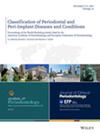Surgical- and implant-related factors and onset/progression of peri-implant diseases: An AO/AAP systematic review
Abstract
Background
The objective of this systematic review was to shed light on the importance of surgical- and implant-related factors on the onset/progression of peri-implant diseases. This systematic review provides an evidence-based overview on the prevention of peri-implant diseases for the Academy of Osseointegration (AO)/American Academy of Periodontology (AAP) Consensus Conference held in August 14–16, 2024 in Oakbrook, IL, USA.
Methods
Systematic screening of electronic sources was performed to identify clinical studies reporting on the impact of surgical- and implant-related factors on peri-implant diseases. To fulfil the inclusion criteria, a composite clinical and radiographic case definition for peri-implant mucositis and/or peri-implantitis had to be reported. Prevalence or incidence (%) of peri-implant diseases was extracted at patient- and implant-level. Moreover, odds/hazard ratios were collected to explore potential associations.
Results
Overall, 34 articles were included in the qualitative synthesis. Of these, 21 explored surgical-related factors (Npatients = 2752, Nimplants = 7591), while 13 reported implant-related factors (Npatients = 1192, Nimplants = 4072). Given the high heterogeneity across the studies, only qualitative assessment was performed. Clinical evidence proved that surgical-related factors, in particular inadequate implant position and, to a lower extent, implants placed in regenerated bone, are more prone to exhibit peri-implantitis, but not peri-implant mucositis. With regards to specific implant-related factors, insufficient evidence, did not allow for exploring specific associations with the onset/progression of peri-implant diseases. However, it was found that a short distance from the prosthetic margin to crestal bone during implant placement may be a predisposing factor for peri-implantitis.
Conclusion
Clinical evidence linking surgical- and implant-related factors and peri-implant diseases is sparsely reported in the literature. Nevertheless, it appears that implant malposition plays a crucial role on the onset/progression of peri-implantitis.
Plain Language Summary
The objective of this systematic review was to shed light on the importance of surgical-and implant-related factors on the onset/progression of peri-implant diseases. Overall, 33 articles were included in the qualitative synthesis. Of these, 21 explored surgical-related factors. Given the high heterogeneity across the studies, only qualitative assessment was performed. Clinical evidence proved that surgical-related factors, in particular inadequate implant position and, to a lower extent, implants placed in regenerated bone, are more prone to exhibit peri-implantitis, but not peri-implant mucositis. With regards to specific implant-related factors, insufficient evidence, did not allow for exploring specific associations with the onset/progression of peri-implant diseases. However, it was found that a short distance from the prosthetic margin to crestal bone during implant placement may be a predisposing factor for peri-implantitis. All in all, implant malposition plays a crucial role on the onset/progression of peri-implantitis.




 求助内容:
求助内容: 应助结果提醒方式:
应助结果提醒方式:


